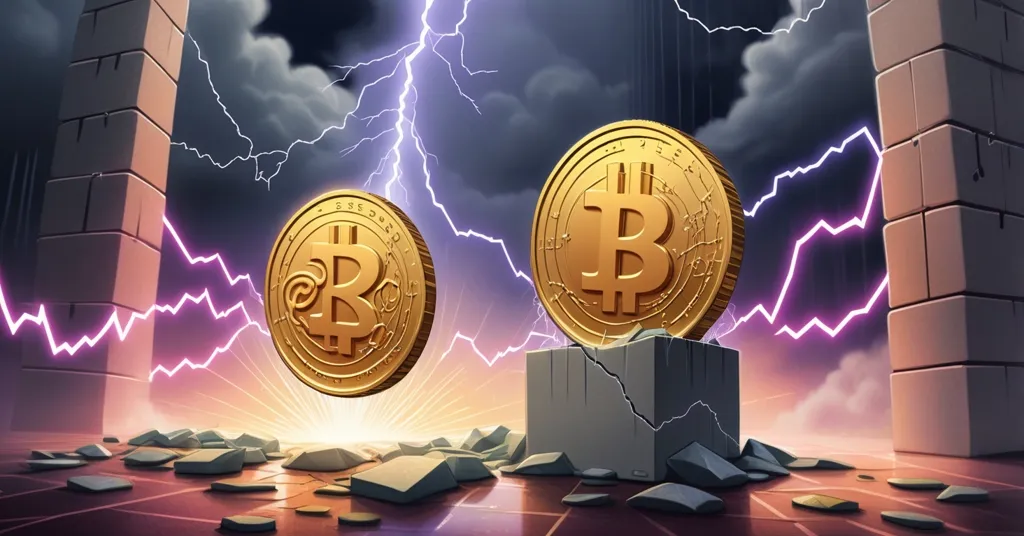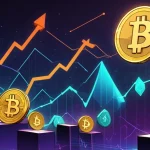XRP Nears $2.33 Resistance: ETF Hopes and Regulatory Moves Fuel Breakout Speculation

XRP at the Crossroads: Will $2.33 Resistance Fall Amid ETF Hopes and Regulatory Moves?
XRP is back in the spotlight, trading at $2.26 with a 1.84% gain over the past 24 hours, and staring down a critical resistance level at $2.33. With institutional cash flooding in, a potential U.S. spot ETF on the horizon, and Ripple’s bold regulatory plays, the stakes couldn’t be higher. Is this the breakout XRP bulls have been waiting for, or another mirage in the volatile crypto desert?
- Price Momentum: XRP up 1.84% to $2.26, nearing key $2.33 resistance tied to 200-day SMA.
- Breakout Stakes: Clearing $2.33 could push prices to $2.60 or $3 if bulls hold strong.
- Institutional Heat: $200M inflow signals big-player confidence, alongside ETF and banking license buzz.
Price Action: Can XRP Breach the $2.33 Barrier?
XRP’s latest move has it hovering at $2.26, a modest but telling 1.84% climb in just 24 hours. The real battleground lies ahead at $2.33, a critical resistance level that’s not just a random figure but a technical linchpin aligned with the 200-day simple moving average (SMA). For those new to the game, think of the 200-day SMA as a long-term trend barometer—it smooths out daily price hiccups to reveal whether the market’s mood is bullish or bearish over months. Breaking this threshold isn’t just about crossing a number; it’s a signal to traders that buyers are taking the wheel.
On-chain analyst Ali has been vocal about the significance of this moment, sharing on social media:
Surpassing $2.33 would be a bullish confirmation, signaling a new phase of upward momentum.
Ali’s take suggests that shattering this barrier could send XRP toward $2.60 in the short term, with $3 within reach if momentum builds. But let’s not pop the confetti just yet. Resistance levels earn their name for a reason—they’re where sellers often regroup to push prices back down. If XRP stumbles here, the $2 mark looms as a critical support zone, a psychological floor where buyers might step in to halt a steeper fall. Worse, a fakeout could play out: a brief spike above $2.33 followed by a swift drop, leaving overeager traders burned. Crypto’s history is littered with such traps, and XRP is no stranger to dashed hopes.
Institutional Power Play: What’s Behind the $200M Inflow?
Beyond the charts, there’s serious muscle backing XRP’s run. Reports indicate institutional investors—think hedge funds, asset managers, or even corporate treasuries, not your average retail trader—have poured $200 million into the token. This isn’t pocket change; it’s the kind of capital that can shift market dynamics by adding sustained buying pressure. When big players move in, it often signals long-term confidence rather than short-term speculation, hinting that XRP is being eyed as more than just a quick flip.
But let’s keep the hype in check. While $200 million sounds impressive, the lack of transparency around who’s buying and why raises eyebrows. Is this genuine conviction, or a well-timed PR stunt to pump sentiment? Without hard data from on-chain analytics or named investors, it’s just a flashy number. We’ve seen “institutional interest” claims fizzle out before, and in a market as manipulative as crypto, skepticism is a survival tool. If this inflow is real, it’s a game-changer; if not, it’s just noise.
Regulatory Game-Changers: ETFs and Banking Licenses
The buzz around XRP isn’t just about price action—it’s about regulatory moves that could redefine its place in finance. First up is the prospect of a U.S. spot XRP ETF, a financial product that would let investors track XRP’s price without owning the token directly, much like existing Bitcoin and Ethereum ETFs. Bloomberg analysts Eric Balchunas and James Seyffart have upped their SEC approval odds to a staggering 95%, signaling near-certainty that XRP could join the mainstream investment club. Seyffart even predicts an “altcoin ETF summer” by late 2025, with XRP potentially leading the charge.
That said, the timeline isn’t immediate—final SEC deadlines stretch to October 2025, giving regulators plenty of room to drag their feet. The SEC’s track record of last-minute rejections or delays on crypto products, like Ethereum staking ETFs, means that 5% doubt could still sting. If approved, though, an ETF could unlock a flood of traditional capital, making XRP accessible to investors wary of crypto exchanges or wallets. It’s a massive step toward adoption, but only if the regulators play ball.
Meanwhile, Ripple, the company closely tied to XRP, is making its own power moves. They’ve applied for a national banking license with the OCC, a bid confirmed by the agency. Think of this as Ripple seeking a VIP pass to operate like a traditional bank, potentially bypassing middleman institutions for faster, cheaper cross-border payments—a core mission since day one. Add to this Ripple’s stablecoin, RLUSD, launched in October 2024 with a $470 million market cap, and you’ve got a company building an ecosystem where XRP could shine as a bridge currency. For clarity, a stablecoin is a digital asset pegged to something steady like the U.S. dollar to avoid crypto’s wild swings. Recent U.S. Senate passage of the GENIUS Act, aimed at clearer stablecoin rules, could further boost confidence in RLUSD and, by extension, Ripple’s vision.
But here’s the rub: cozying up to regulators might legitimize Ripple, yet it risks diluting the rebellious spirit of blockchain. From a Bitcoin maximalist lens, XRP’s centralized nature—Ripple controls much of its supply—already clashes with decentralization’s ethos. Is this integration a win for adoption, or a sellout to the very systems crypto was meant to disrupt? It’s a tightrope walk.
Technical Signals: XRP vs. Bitcoin and Market Risks
Digging into the charts, XRP’s performance against Bitcoin offers a glimmer of hope. The XRP/BTC trading pair has broken out of a falling wedge pattern, a technical setup often seen as a bullish reversal. In simpler terms, this pattern forms when price lows and highs trend downward but tighten, frequently leading to a sharp upward swing when breached. For XRP, outpacing Bitcoin—even temporarily—is no small feat in a market where the king of crypto often steals the spotlight. If this holds, it could lure more capital into XRP’s corner, especially during altcoin-friendly market phases.
Yet, technicals alone don’t guarantee a rally. XRP’s history of flirting with key levels only to falter is a nagging reminder of crypto’s volatility. Broader market sentiment, Bitcoin’s dominance swings, or a sudden risk-off mood could derail this uptrend faster than you can say “bear trap.” Traders banking on patterns like falling wedges need to pair them with volume spikes or news catalysts to avoid betting on thin air, as discussed in some technical analyses of the $2.33 resistance.
Ripple’s Vision: Competing in a Crowded Field
Zooming out, Ripple’s ambitions go beyond XRP’s price—it’s about carving a niche in global finance. XRP was designed as a bridge for instant cross-border settlements, a direct challenge to sluggish systems like SWIFT that can take days and hefty fees to process payments. With RippleNet, their payment network, and partnerships with financial institutions, XRP has a use case Bitcoin doesn’t touch. Bitcoin is digital gold; XRP aims to be digital grease for the financial machine. Tie this to RLUSD’s stablecoin play, and Ripple’s ecosystem looks promising—if it can execute. For more background on XRP and its underlying technology, it’s worth exploring further.
Competition, however, is fierce. Circle, behind the USDC stablecoin, is also chasing a national trust bank charter, while altcoins like Solana and Litecoin are in the ETF race. If Ripple’s banking bid hits regulatory snags or XRP’s utility fails to stand out, it risks being overshadowed. The crypto-to-tradfi bridge is a crowded highway, and not everyone gets a lane.
Risks and Reality Checks: Why XRP Isn’t a Sure Bet
Let’s cut through the optimism with some harsh truths. XRP’s hype cycles are as old as altcoins themselves, often followed by brutal letdowns. Ripple’s lingering SEC legal battle, though not the focus here, still looms like a dark cloud. Even with high ETF approval odds, as noted in recent analyses on XRP ETF prospects, the SEC has a knack for throwing curveballs—don’t be shocked if that 5% chance turns into a gut punch. And that $200 million institutional inflow? Without names or proof, it could be smoke and mirrors, a classic crypto ploy to juice sentiment.
Then there’s the centralization critique. Unlike Bitcoin’s leaderless, untouchable network, Ripple’s grip on XRP supply makes purists cringe. From an effective accelerationism (e/acc) perspective, sure, XRP’s regulatory plays could speed blockchain’s march into Wall Street—but at what cost to the ethos of freedom and privacy? Plus, if $2.33 holds as a wall, or if altcoin rivals steal the spotlight, sentiment could flip overnight, as some community discussions on XRP’s resistance challenges highlight. Crypto’s a ruthless arena; XRP’s no exception.
What’s Next for XRP?
XRP stands at a pivotal juncture, fighting for relevance on multiple fronts: price charts, regulatory wins, and institutional trust. Breaking $2.33 could ignite a rally to $2.60 or beyond, while ETF approval and a banking license might cement its place in finance. Yet, the risks—volatility, regulatory whims, and Ripple’s baggage—are as real as the rewards. Keep your eyes on upcoming OCC decisions, SEC rulings, and market momentum. XRP might crack that resistance, but can it crack the skepticism and prove it’s more than a corporate coin in a decentralized dream, especially as Ripple’s regulatory moves could impact XRP’s price?
As a final note of caution, beware of XRP-related scams or fake ETF news swirling on social media. Price predictions are speculative at best, often weaponized by pump-and-dump schemers. Stay sharp, do your own research, and don’t fall for the hype merchants peddling guaranteed moons. We’re here for adoption, not exploitation.
Key Questions and Takeaways on XRP’s Moment
- What’s driving XRP’s push toward $2.33?
A 1.84% rise to $2.26, fueled by a $200 million institutional inflow, alignment with the 200-day SMA, and ETF approval optimism, is propelling the momentum. - Why is $2.33 such a critical level for XRP?
This resistance marks a technical and psychological barrier; breaching it could confirm bullish strength, targeting $2.60 or $3 with sustained buying power. - How could a spot XRP ETF impact its future?
With a 95% SEC approval chance, an ETF could mirror Bitcoin and Ethereum’s mainstream success, easing investor access, though deadlines extend to October 2025. - What’s the significance of Ripple’s banking license bid?
Securing a national charter with the OCC could integrate XRP into regulated finance, boosting credibility and enabling faster payments without intermediaries, as explored in some discussions on Ripple’s banking impact. - Are technical signals enough for an XRP rally?
The XRP/BTC falling wedge breakout hints at a bullish turn, but volatility and potential resistance failure mean broader market confirmation is crucial. - What risks could derail XRP’s momentum?
SEC unpredictability, unverified institutional data, centralization concerns, and altcoin competition could halt progress, even if $2.33 falls.



